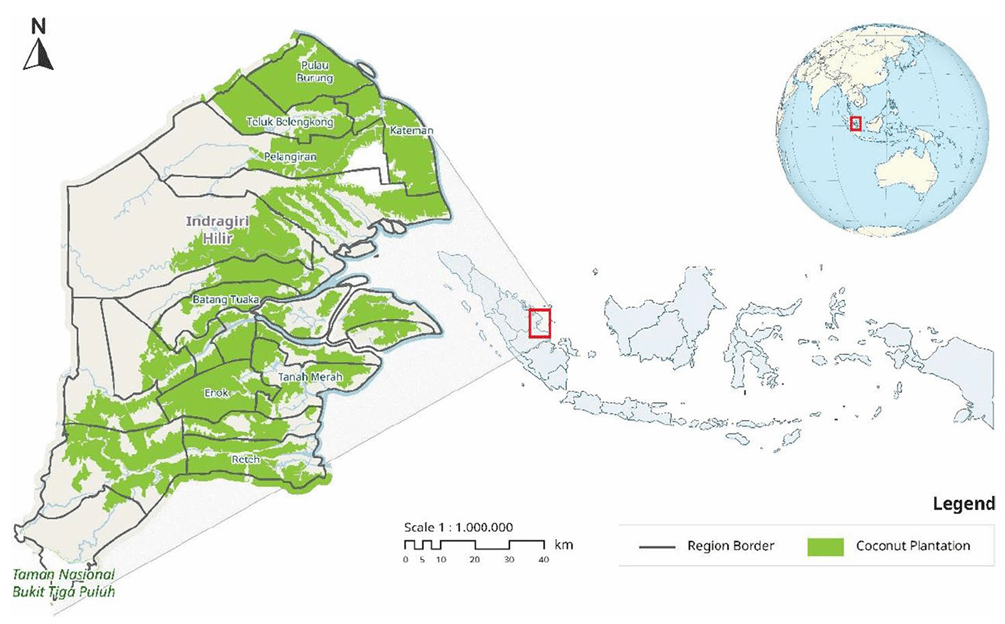Agroforestry in Indragiri Hilir: Building Food Security and Peatland Resilience
September 25, 2025 16:34
Agroforestry in Indragiri Hilir: Building Food Security and Peatland Resilience
Rice Prices and Pressures on Farmers
Despite Badan Pusat Statistik (BPS)’s projections of a national rice surplus until October 2025, the market reality tells a different story. BPS’ August report, supported by Badan Pangan Nasional (Bapanas) price monitoring, shows that rice prices across Indonesia continue to climb while supplies remain fragile. This same trend is evident in Riau, particularly in Indragiri Hilir (Inhil), where Tembilahan recorded the highest inflation rate in the province.
For coconut farmers, who make up the majority of Inhil’s population, these rising prices further add to their daily burden of food costs. With most of their income already absorbed by food expenses, these increasing costs put families’ livelihoods and overall welfare at a higher risk.
This vulnerability is a result of several factors. Part of it lies in how food reaches the region. Most foods sold in Inhil travel long and costly supply chains, leaving prices highly dependent on neighboring regions’ supply, logistics, and upstream costs. On top of this, there are undiversified income sources of the farmers. As a peatland community, most of the coconut farmers rely solely on coconuts, with a harvest cycle of up to three months. The reliance on the long harvest of coconuts leaves households vulnerable to market fluctuations and limited economic resilience.

How Climate Risks Threaten Coconut Farmers on Peatlands
Climate change's presence is also making things even harder. Farmers around the world are now facing intensified extreme weather events and natural disasters, and Indonesia is no exception. In Inhil, the impact is uniquely complex. This is because most of its community-based coconut plantations are long cultivated on peatlands, a naturally vulnerable type of land that requires careful ecological management even without climate challenges.
The challenges are now multiplying with the rising climate risks. Longer droughts, harsher heat, and greater chances of floods, fires, and land subsidence are leaving peatlands increasingly exposed to degradation, as noted by Pantau Gambut. These changes not only disrupt farming activities in Inhil but also potentially worsen climate change itself if not treated responsibly, creating a dangerous cycle.
To add to the list, climate change also fuels the outbreak of pests and diseases. According to the Indonesian Ministry of Agriculture, the escalating global temperatures, rising humidity, intensifying natural disasters, and shifting seasons potentially speed up the life cycle of pests and expand their reach. For farmers in Inhil, this means harvests are increasingly at stake, which impacts the stability of their source of income.
When agricultural production is shaken and the overall food stock is threatened, the impacts may spill far beyond the fields. Coconut farmers are getting more prone to lose income for longer periods, overall food supplies in markets shrink, and food prices climb higher. Not to mention, for families, this also translates into fewer affordable and accessible options for nutritionally-balanced food. Over time, these pressures may deepen inequality and worsen food insecurity.
Agroforestry: A Way Forward for Farmers and Peatlands
This doesn’t have to be the end of the story. Zooming out to the wider farming communities in Indonesia, there are many farming practices that are recognized traditionally which are proven to strengthen the land while also securing livelihoods. One promising approach for coconut farmers in Inhil to implement is agroforestry systems.
In this case, farmers can start with one of agroforestry’s simplest forms: intercropping system. This system is done by combining coconuts with other diverse crops and trees that are suitable for peatlands—such as areca nut, banana, cassava, pineapple, and, occasionally, liberica coffee. By diversifying what grows on the land, farmers can make the most of peatlands economically while also protecting them ecologically, especially to face climate change.
Economically, agroforestry offers a vital safety net. By adding crops with shorter harvest cycles, farmers gain more regular income streams between coconut harvests. For example, as our research brief titled Coconut-based Agroforestry-Paludiculture to Improve Peatlands Sustainability and Food Security mentioned, pineapples make an excellent intercrop for coconuts on peatlands. This is because they grow well in peatlands and require minimal fertilizer or maintenance. Intercropping coconuts with pineapples not only boosts land productivity but also offers stability for families when challenges arise.
On the ecological part, our research brief noted that this approach may also improve soil health, create natural barriers against pests and diseases, and support biodiversity. In turn, these benefits make farming more resilient to climate risks while also sustaining the surrounding environment.
Toward a More Resilient and Sustainable Future
Agroforestry shows that farming can be both climate-smart and people-centered. For coconut farmers in Inhil, it offers a way to safeguard harvests, diversify income, and protect the fragile peatlands they depend on.
To learn more, explore our research brief here. On a further note, join our World Food Day webinar with Zentide and Greeneration Foundation on October 16, 2025 to explore how agroforestry can strengthen Indonesia’s future food system. Don’t miss it—and follow us on Instagram and LinkedIn for updates!
RELATED
ARTICLE
Kobexindo Tower – 2nd Floor, Jl. Pasir Putih Raya Blok No.E-5-D, Ancol, Pademangan, North Jakarta, Indonesia, 14430
Phone: (021) 6603926
WhatsApp: +62 815 8855 584
Privacy Policy
Copyrights © 2025 Tay Juhana Foundation